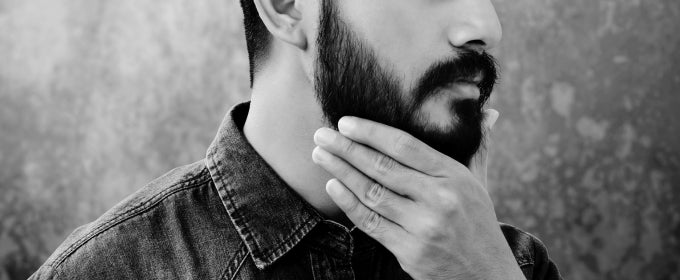
Beard Dandruff - How to Treat & Prevent It
Experiencing frequent itchiness, redness of skin, and white flakes in beard hair? You may have beard dandruff.
Beard dandruff is a common skin condition that can be frustrating to deal with — the constant itching, not to mention the unsightly flakes in the beard can affect both comfort and confidence.
Just like with dandruff for head hair, there are several effective ways to treat beard dandruff as well as preventive measures you can use to make sure it’s gone for good. Read on to find out what causes beard dandruff, and how you can get rid of it.
What causes beard dandruff?
The primary culprit for beard dandruff is a microbe that is present on everybody’s skin called Malassezia globosa.
Malassezia globosa exists on the skin to help break down the natural oils skin produced by the skin, called sebum. As part of this process, oleic acid is produced, which happens to be a chemical that causes skin irritation in some people, especially those with sensitive skin.

The oleic acid irritates the skin, causing it to become red and itchy, which in turn prompts the body to produce more skin cells to replace the irritated areas. As they are replaced, the old skin cells clump together to form what we know as white dandruff flakes.
What this means is that those who have naturally oily skin, a greater sensitivity to oleic acid, or a combination of both will be especially susceptible to developing beard dandruff.
The link between beard dandruff and skin conditions
In some cases, beard dandruff can be a symptom of underlying skin conditions rather than a condition of its own. The most common skin condition linked to beard dandruff is seborrheic dermatitis, which has more severe symptoms than regular beard dandruff.
Seborrheic dermatitis often results in larger, more intense flaking patches, which may take on a yellowish appearance. In addition to the face area, the flaking can also appear on the chest, back, and scalp.
The best approach to finding out whether the flakes in your beard are due to beard dandruff or seborrheic dermatitis is to simply try and treat it normally. If the condition continues to persist even after treatment, it may be time to see a dermatologist for an accurate diagnosis.
How to get rid of beard dandruff

Beard dandruff can be frustrating, but it’s not impossible to deal with, especially by applying the proper and consistent beard care.
Wash regularly
The build-up of dirt and oil is one of the most common sources of beard dandruff, especially for thicker or longer beards. Using a gentle beard shampoo or cleanser to clean the beard and the face skin around it can help remove flakes and soothe the skin.
Apply conditioner
Dry skin can exacerbate the problem of beard dandruff. Applying a beard conditioner to the beard and skin can help to keep it hydrated. Using a beard oil or balm can also help with moisturisation.
Exfoliate skin
Use a beard brush to gently exfoliate the skin under and around the beard to remove the build-up of dead skin cells that may clump into flakes.
Incorporating these steps into your personal care routine can make a significant difference in the presence of beard dandruff. Most people will start to notice a general reduction in beard dandruff within 2-4 weeks of applying proper beard care.
If the issue of beard dandruff still persists even after applying consistent care, it may be time to pay a visit to a dermatologist for professional advice.
Can you use anti-dandruff hair shampoo for a beard?
Beard dandruff shares many of the same causes as scalp dandruff, which leads many people to believe that they can be treated in the same way.
While there are some merits to this, it’s not fully applicable to everyone. Individuals can have differing skin sensitivity on the scalp and the face, with face skin tending to have higher sensitivity.
Using the same anti-dandruff hair shampoo on a beard is generally possible, but it can also cause irritation for those with more sensitive face skin. Some anti-dandruff shampoos can also dry out beard hair, especially if it's already coarse or dry.
Our advice? Consider using beard shampoo — these are specially formulated with beard hair and skin sensitively in mind and will be more beneficial in the long term.
Advice for preventing beard dandruff

Once you’ve finally gotten rid of beard dandruff, the next step is to prevent it from coming back. Aside from the beard care steps we’ve outlined above, you should also:
- Avoid applying harsh skin products that contain chemicals that can irritate your skin.
- Eat a balanced diet packed with nutrient-rich food to promote good skin health, and avoid greasy foods that cause your skin to produce more oil.
- Drink plenty of water to keep your skin hydrated.
- Practice mindfulness to manage your level of stress — having high stress levels can potentially result in oily and sweaty skin.
- Trim beard hair regularly to remove split ends and dead hair for a better looking and healthier beard.
At Jericho, we have a collection of premium beard care products from beard shampoos to our anti-beardruff kit which provides everything you need to say goodbye to dry and flaky skin.
